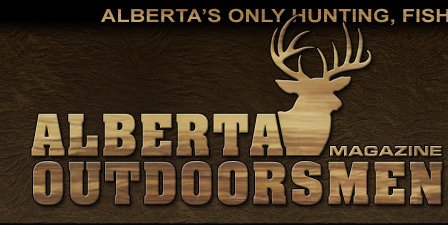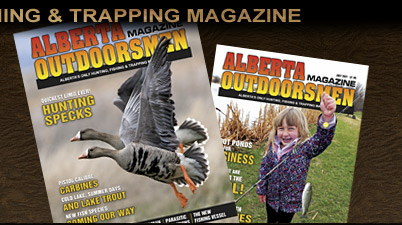It began one cold, winter day in the middle of January, as I was walking down the overgrown dead-end farm road. I had coyote snares hanging under the barbwire fence in the places where the coyote trails would force the coyotes to crawl under the fence. Twelve-inch loops set three inches from the ground or hard-packed drifted snow. There was less snow on the roadside of the brushy fence line, and the neighbour had plowed the three-foot snowdrifts off the road so that he could haul hay bales and oat straw to his black angus cattle pastured in the field on the opposite side of the road. I looked down, noticing a set of canine tracks that were unlike the coyote tracks that normally littered the road surface after a nighttime snow flurry. These were large, some 3-inches wide by 4-inches long! The neighbour’s dog, a brown Labrador retriever crossed with a Great Dane, didn’t normally travel this far from his home. After following the trail for a little while to see where the tracks originated and where they went, and finishing the trap check for the day, I had time to think about what I had seen. I was intrigued!
When I got home, I called the neighbour to see if they could take their dog down the road to leave a paw print near the wild prints to see if the unknown tracks were the same. They weren’t! The wild canine’s tracks were larger! Not much larger, but definitely larger!
The following year found two sets of large wild canine tracks on the roadbed, three sets the following year, and four sets the year following that. Then nothing during the fifth year of trapping season. No sign of where these animals went or were. Nothing!
According to the fossil record, there is a coyote and there is a timber wolf. There is nothing in between. These tracks were larger than a coyote’s yet smaller than a large timber wolf, but what made them?
Then along came the sightings...
As I finished another trap check of empty coyote snares, feeling the warm, late afternoon winter sunshine on my face, I found a seat on the fence crossbar near the barbwire western gate. As I sat adjusting my posture to put my back toward the cold wind blowing out of the northwest, I spied something moving into view along a snow-filled drainage ditch. It was brown and on four legs. At first I thought it was a coyote. Then the large, brown animal suddenly stopped; it had realized what I was and where I was! It had crossed downwind into my wind-blown scent trail. After an unknown length of time, probably just seconds, the canid suddenly wheeled and started to run away with its brush of a tail held high over its back.
“Is that a wolf?” I asked myself aloud.
Once again, it stopped, turning broadside with its tail hanging at an oblique 45 degrees toward the ground.
“No,” I replied. “That’s a coyote!”
Then turning and running away with its tail held high over its back, I thought “Wolf!” Then stopping briefly with its tail hanging toward the ground... “coyote!”
This continued until the canine disappeared into a patch of brush and was gone from view. It has never been seen since.
Was it a coyote? Was it a wolf? Was I day dreaming... again? I just did not know!
After this incident came the community gossip. “Did you hear? Buddy saw a black wolf run across his front yard. He grew up in the North, he knows a wolf when he sees one!”
Then came a report by a friend about something weird running through the trees, on the edge of the pasture, near my own house, onto the old overgrown farm road and across the neighbour’s field. He said that it was a large canine with a lion’s mane on its shoulders, orange, the colour of Jello Butterscotch Instant Pudding with big, wide shoulders and a small, narrow hind end. “Kind of like an old breed of bulldog on steroids!” Was this yet another ‘Hound of the Baskerville’s part of the pack, or was it unrelated?
Figuring that I was dealing with timber wolves (the season was open and I was permitted to trap them in my wildlife management unit), I purchased a jar of Forsyth’s Timber Wolf Call Lure, a jar of Timber Wolf Gland Lure, and a bottle of wolf urine and set up a scent post set with a pair of newly acquired and newly dyed Bridger #5 offset coil spring, foothold traps near where I saw the brown beast. With this set, I managed to frighten off literally everything in the countryside – no wolves, no coyotes, no foxes, no weasels, no red squirrels, no mice, voles, ravens, magpies, chickadees – NOTHING! Nothing at all went near this set. Even after removing the set in its entirety, nothing went near the area for the rest of the season. Coincidence? Something else to make me go “Hmmm!”
Now, it’s been said that I’m not the brightest bulb in the chandelier but at this point, I was pretty sure that I wasn’t dealing with big northern timber wolves. So... just what was I dealing with? Time for research...
I found pictures on the Internet of individuals holding a varmint rifle and a large reddish/tan canine, which they called a coywolf, some four to five feet in length with a massive chest and petite feet. Other folks holding eastern coyotes, “half wolf, half coyote”. I saw pictures of diminutive sized “wolves” running around Algonquin Provincial Park in Ontario that were reported to be half wolf, half coyote. A protected hybrid species. Is this what has “arrived” on my trapline? Has the spread of the eastern coyote east run out of land, and like the ripples on a pond, is now expanding its range to the west? Am I dealing with a half wolf, half coyote hybrid? A coywolf! I needed answers to these questions.
First, I called the nearest Fish and Wildlife office (located an hour long drive, one-way, down the old, pot holed, tertiary highway). My enquiry for information on wolves and especially on “coywolves” was met with loud derision from the clerk. “We only deal with factual animals, NOT fictitious animals!”
I was directed to use a computer with Internet capabilities since the Province no longer uses the Queen’s Printer to produce colourful information posters on provincial wildlife.
Second, I found myself with a sore back, stiff shoulders, and wrists with carpel tunnel pain from sitting before a computer for a long time trying to figure out what these cryptids really were.
To summarize my research, there are only wolves, coyotes and foxes for wild canines throughout the North American continent. As the fox is the smallest of the wild canines, they can be ruled out. The largest canines are wolves with the largest located in the Arctic, and the smallest wolves are found in Mexico. According to the US Fish and Wildlife Service, there are 24 subspecies of wolf in North America, including both the living and the extinct.
In the Province of Alberta, where I live, there are five possible subspecies ranging from the large Canis lupus occidentalis – the Mackenzie Valley Wolf (in the north), Canis lupus griseoalbus – Saskatchewan’s Grizzly or Elusive Wolf (in the east, northeast), Canis lupus columbianus – B.C. Wolf (in the extreme southwest), and Canis lupus irremotus – the Northern Rocky Mountain Wolf (in the west following the Rocky Mountains east into the foothills). The possibility does exist that remnant populations of the Plains Wolf (Canis lupus nubilus) also are found in the province. I have heard wolf howls emanating from Elk Island National Park and from the Ministik Bird Sanctuary, both found in east-central Alberta.
My research also found that according to a provincial biologist, there are three subspecies of coyote in Alberta. The smallest being the pale Prairie Coyote found in the south and east-central regions. The larger, and darker Mountain Coyote, found in the west (the foothills of the Rockies), and the larger yet reddish Northwestern Coyote found throughout the Northern “grand prairie”.
Since I live and trap on the last farms before the boreal forest and the Rocky Mountain foothills of west-central Alberta, half way between Alaska and Mexico, I figure I must have medium-sized wolves and medium-sized Mountain Coyotes (might explain why my coyote pelts average an extra-large grade at NAFA auctions).
Since these large, wild canines have scared off all of the coyotes (just when coyote prices are on the up), I figured they must be wolves. Even I know that wolves and coyotes are not tolerant of one another anymore than are coyotes of the red fox. This means that the time has come to learn and put into practice what has been learned!
If I am dealing with wolves and an actual wolf pack, I need some actual how-to knowledge on how to catch a wolf. Since my mainstay for trapping information, in the past, has been the public library and the Provincial Archives with its Canadian and American published trapping books and magazines, and with the wolf listed federally in the USA as endangered, except for the odd magazine article written by an Alaskan, there has been a dearth of how-to articles on catching wolves. I did find an old dusty copy of an English translated French Canadian essay with a few wolf sets described to give me at least a suggestion of how to set for the wolf. After all, it is much better to learn from those with experience than to try to “reinvent the wheel.”
I read that behind the hype, if one can catch a coyote, then one can indeed catch a wolf! And I have caught plenty of coyotes.
Whenever I set a foothold trap in the winter, it is a given that we will get a heavy dump of snow followed by high winds that drifts the snow several feet deep right over the set trap! As a result, I have learned to use snares in the wintertime.
In reading the French Canadian essay, I found out that the snare loop of a wolf snare should be the same diameter as the distance from the trapper’s waist to the knee. A snare is usually hung approximately two-inches shorter than the diameter of the snare from the ground. Problem is I’m a very tall man and setting a snare 24” in diameter and 22” from the ground corresponds with a method for poaching deer. Not the intended target. Honest! Since the “old” coureur de bois were of “average” height, the wolf snare diameter would have been approximately 18” and set 16” from the ground, which makes more sense!
I also read that a short snare of large aircraft cable is used and attached, usually with a swivel, to a heavy duty, large gauge tie wire. So I made a couple dozen wolf snares using five feet of 1/8” 7 x 7 aircraft cable with a camlok and a double ferrule. I then cut five feet of #9 gauge annealed tie wire. I twisted a swivel into the tie wire, passed the aircraft cable through, slid on a very small washer, and crimped on a single ferrule. After boiling and dying the snares, I was now outfitted for next season and the capture of these wolfish canines.
Stay tuned next month for Part II. ■
For previous Reader Stories click here.
|


